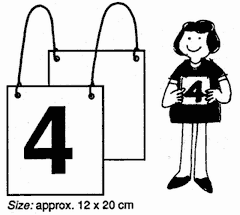At least one set of cards numbered from 0 to 10 that are large enough to be worn by the children.
Additional cards as indicated by scenarios in the lesson plan.
Laminating these cards will preserve them.
| Years: | K - 3 | Time: | Many lessons | Strand: | Number |
|---|
This lesson includes activities of children 'being' numbers. Groups of children wearing number cards act out events so that the whole class can talk about the mathematics involved. The activities are visited and revisited over days/ weeks/ months (threaded through the curriculum) so that children have a chance to construct and reconstruct their number concepts.

At least one set of cards numbered from 0 to 10 that are large enough to be worn by the children.
Additional cards as indicated by scenarios in the lesson plan.
Laminating these cards will preserve them.
The children could do similar activities with small number cards on the table top. What difference does it make to the learning to present the activities in the kinaesthetic manner suggested?
Can the mathematical conversation be recorded in a way that concurrently achieves literacy objectives?
After teaching the lesson, please rate each of the above features (out of 10) as to its contribution to the overall quality of the learning experience. This exercise will provide a basis for staff discussion of curriculum development.
This is lesson 142 within Education Services Australia’s Maths300 project www.maths300.esa.edu.au. An earlier version was published within the MCTP Activity Bank Volume 1, p189.